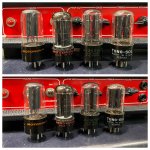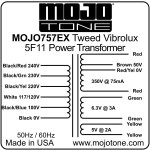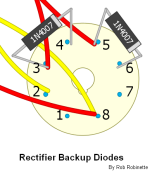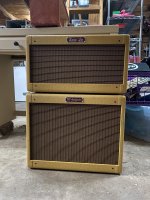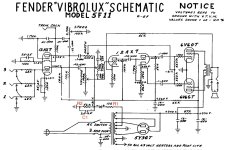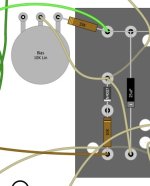coltonius
Well-known member
Ahoy there, fellow amp building enthusiasts.
This week I've been going through my very first amp build, a 5F11 Vibrolux kit from Mojotone. Now that I have several amp builds under my belt, I decided it was time to clean up the wiring and do a general safety check. I was reminded that the voltages have been high since I built it, but it's technically within spec at +20%.
It sounds great by the way!
Anyway, I checked the voltages last night and measured B+ at 415v, where 340v is typical. I don't expect to drop B+ by 75 volts, but I'd like to bring it down by at least half! In the past, I have successfully used Rob Robinette's zener diode stack to reduce voltage; both amps were cathode-biased, though. On this amp, the zener stack raised the B+ to 425v! What the shell?!
So here's where I need help:
1. Is it possible to lower the B+ without a bucking transformer? I prefer a solution that is both self-contained and permanent.
2. Why the heck didn't the zener stack work?
**I will retrieve the rest of the voltages later this evening; I don't remember them off the top of my head, but they were all high.
The 5F11 schematic is attached, but here's the RobRob zener diode diagram:
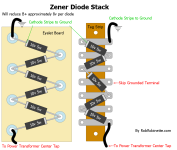
This week I've been going through my very first amp build, a 5F11 Vibrolux kit from Mojotone. Now that I have several amp builds under my belt, I decided it was time to clean up the wiring and do a general safety check. I was reminded that the voltages have been high since I built it, but it's technically within spec at +20%.
It sounds great by the way!
Anyway, I checked the voltages last night and measured B+ at 415v, where 340v is typical. I don't expect to drop B+ by 75 volts, but I'd like to bring it down by at least half! In the past, I have successfully used Rob Robinette's zener diode stack to reduce voltage; both amps were cathode-biased, though. On this amp, the zener stack raised the B+ to 425v! What the shell?!
- The diodes were oriented correctly, and HV center tap was soldered in the right place. Didn't make a difference.
So here's where I need help:
1. Is it possible to lower the B+ without a bucking transformer? I prefer a solution that is both self-contained and permanent.
2. Why the heck didn't the zener stack work?
**I will retrieve the rest of the voltages later this evening; I don't remember them off the top of my head, but they were all high.
The 5F11 schematic is attached, but here's the RobRob zener diode diagram:

Attachments
Last edited:


